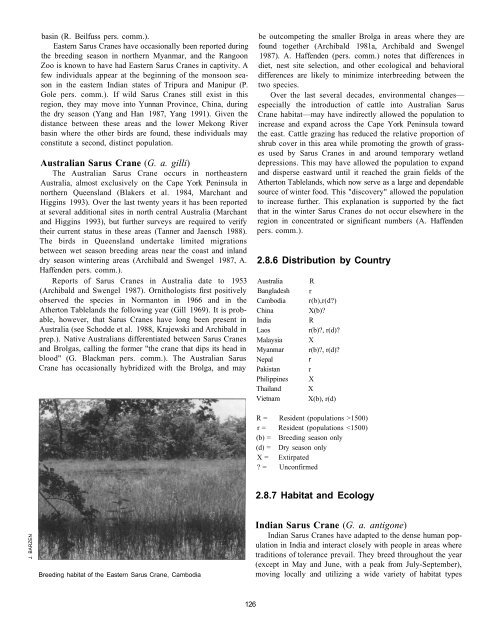The Cranes IUCN
The Cranes IUCN
The Cranes IUCN
You also want an ePaper? Increase the reach of your titles
YUMPU automatically turns print PDFs into web optimized ePapers that Google loves.
J. BARZEN<br />
basin (R. Beilfuss pers. comm.).<br />
Eastern Sarus <strong>Cranes</strong> have occasionally been reported during<br />
the breeding season in northern Myanmar, and the Rangoon<br />
Zoo is known to have had Eastern Sarus <strong>Cranes</strong> in captivity. A<br />
few individuals appear at the beginning of the monsoon season<br />
in the eastern Indian states of Tripura and Manipur (P.<br />
Gole pers. comm.). If wild Sarus <strong>Cranes</strong> still exist in this<br />
region, they may move into Yunnan Province, China, during<br />
the dry season (Yang and Han 1987, Yang 1991). Given the<br />
distance between these areas and the lower Mekong River<br />
basin where the other birds are found, these individuals may<br />
constitute a second, distinct population.<br />
Australian Sarus Crane (G. a. gilli)<br />
<strong>The</strong> Australian Sarus Crane occurs in northeastern<br />
Australia, almost exclusively on the Cape York Peninsula in<br />
northern Queensland (Blakers et al. 1984, Marchant and<br />
Higgins 1993). Over the last twenty years it has been reported<br />
at several additional sites in north central Australia (Marchant<br />
and Higgins 1993), but further surveys are required to verify<br />
their current status in these areas (Tanner and Jaensch 1988).<br />
<strong>The</strong> birds in Queensland undertake limited migrations<br />
between wet season breeding areas near the coast and inland<br />
dry season wintering areas (Archibald and Swengel 1987, A.<br />
Haffenden pers. comm.).<br />
Reports of Sarus <strong>Cranes</strong> in Australia date to 1953<br />
(Archibald and Swengel 1987). Ornithologists first positively<br />
observed the species in Normanton in 1966 and in the<br />
Atherton Tablelands the following year (Gill 1969). It is probable,<br />
however, that Sarus <strong>Cranes</strong> have long been present in<br />
Australia (see Schodde et al. 1988, Krajewski and Archibald in<br />
prep.). Native Australians differentiated between Sarus <strong>Cranes</strong><br />
and Brolgas, calling the former "the crane that dips its head in<br />
blood" (G. Blackman pers. comm.). <strong>The</strong> Australian Sarus<br />
Crane has occasionally hybridized with the Brolga, and may<br />
Breeding habitat of the Eastern Sarus Crane, Cambodia<br />
126<br />
be outcompeting the smaller Brolga in areas where they are<br />
found together (Archibald 1981a, Archibald and Swengel<br />
1987). A. Haffenden (pers. comm.) notes that differences in<br />
diet, nest site selection, and other ecological and behavioral<br />
differences are likely to minimize interbreeding between the<br />
two species.<br />
Over the last several decades, environmental changes—<br />
especially the introduction of cattle into Australian Sarus<br />
Crane habitat—may have indirectly allowed the population to<br />
increase and expand across the Cape York Peninsula toward<br />
the east. Cattle grazing has reduced the relative proportion of<br />
shrub cover in this area while promoting the growth of grasses<br />
used by Sarus <strong>Cranes</strong> in and around temporary wetland<br />
depressions. This may have allowed the population to expand<br />
and disperse eastward until it reached the grain fields of the<br />
Atherton Tablelands, which now serve as a large and dependable<br />
source of winter food. This "discovery" allowed the population<br />
to increase further. This explanation is supported by the fact<br />
that in the winter Sarus <strong>Cranes</strong> do not occur elsewhere in the<br />
region in concentrated or significant numbers (A. Haffenden<br />
pers. comm.).<br />
2.8.6 Distribution by Country<br />
Australia<br />
Bangladesh<br />
Cambodia<br />
China<br />
India<br />
Laos<br />
Malaysia<br />
Myanmar<br />
Nepal<br />
Pakistan<br />
Philippines<br />
Thailand<br />
Vietnam<br />
R<br />
r<br />
r(b),r(d?)<br />
X(b)?<br />
R<br />
r(b)?, r(d)?<br />
X<br />
r(b)?, r(d)?<br />
r<br />
r<br />
X<br />
X<br />
X(b), r(d)<br />
R = Resident (populations >1500)<br />
r = Resident (populations

















